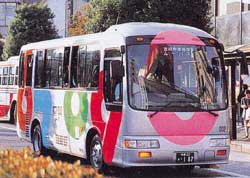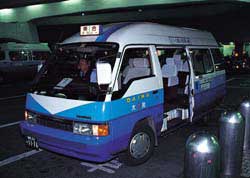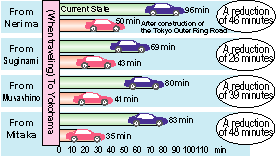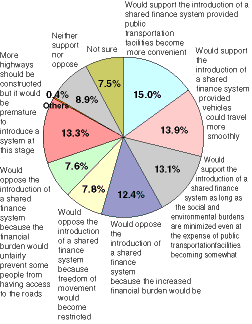| For the transportation of children attending school
and elderly passenger in rural centers and major urban areas, it is crucial
that public operators cooperate with private operators to undertake their
important role in providing efficient and adequate transport services that
meet the needs of passenger. Regarding the issues of bus traveling speeds
and improving punctuality, operators will need to work with related government
agencies and local authorities since there are aspects of these issues that
cannot be resolved independently. In addition, taxis, which provide mobility, are a public transportation system, which can meet the needs of individual passenger. Using the abolition of the restrictions on the regulation of demand and supply as a starting point, it can be expected that the ingenuity of the operators will lead to various excellent services being provided to consumers. |
Community Bus |
Share-ride Taxi-bus |
||
| These small-to medium-sized buses can run even on the narrow streets in residential neighbourhoods, and the undertaking of measures such as shortening the distance between bus stops has made these buses more accessible. | These taxi-buses, an amalgam of a bus and a taxi, provide good service by using larger than normal taxi vehicles. | ||
 |
 |
||
| A "Move Us" Bus in operation
in Musashino city. The term "Move Us" is a made-up nickname originally suggested by a member of the public. |
An urban share-ride taxi-bus operating on city streets |
| The use of private vehicles, which provide very convenient
travel door-to-door and offer the excellent mobility that is not available
in mass transportation systems, has grown as a means to widen peoples' fields
of activity and satisfy varying needs. In addition, the trucks, which play
the dominant role in urban distribution systems, have increased their total
time on the road in response to the increase in demand for frequent courier
services. These trucks account for a large percentage of urban transport. However, urban transportation is characterized by the existence of overwhelming space constraints. At present, major cities with extreme traffic congestion are committed to the construction of bypasses and ring roads. This road construction should be vigorously pushed forward but, as a result of difficulties such as acquiring the necessary land, progress is not being made quickly enough. As a result, even though the average traveling speeds of vehicles during hours of congestion in major cities are expected to increase in the near term, the long term prospects are for a speed decrease and thus buses, taxis, private vehicles and trucks will all become less convenient. |
A Comparison of Ring Road Networks in Major Cities |
Examples of the Advantages of the Tokyo Outer Ring Road |
||
| The absence of ring roads in large cities is one factor that can produce traffic congestion in urban centers. It is hoped that ring roads will be constructed quickly. |  |
||
 |
|||
| Source: Produced by the National Land Agency, based on the "2000 White Paper on Construction" compiled by the Ministry of Construction |
Source: Ministry of Construction, Tokyo metropolitan government website |
| Under these conditions, public awareness of the negative
aspects of motor traffic (for example, environmental problems, traffic accidents
and road congestion) has risen to unprecedented levels. Because citizens
enjoy the convenience offered by motor vehicles, what role these vehicles
should play in urban areas is the topic of much debate. It goes without saying that this issue affects the freedom of citizens' lifestyles and that extreme care must be taken in responding to the problem. However, the fact remains that this problem will not be solved unless action is taken. Consider the following points - The citizens demanding a comfortable and secure living environment are in line with the new age, and their calls will further increase in the future. - Although previously there had been a tendency to use private vehicles rather than travel by foot, in recent times some citizens increasingly want to be able to walk comfortably around town. - In foreign countries that have been grappling with these problems in the past, TDM8 (Transportation Demand Management) measures such as restricting the use of vehicles in central city areas and promoting greater use of public transport facilities have been put into practice. - Japan, after observing the efforts of foreign countries, has also begun to gradually carry out pilot experiments in order to realize an urban transportation system that gives preference to public transport facilities. - As space restrictions tighten in metropolitan areas, it will become more difficult to construct effective roads. - A technological infrastructure is rapidly being put into place to manage the gathering, analysis and provision of information regarding motor traffic and public transport now available due to the development of information technology. When the above points are considered, now is the time when we should aspire to select measures that seek to create cities and transport that are not overly reliant on private motor vehicles. For formulating transport policy, we need a framework to stimulate consensus-building in particular areas concerning such options. |
Which sports and activities would you like to try? |
|
From among 11 possible options, walking came in first place. Running was placed fifth. | |||||||
| Source: The Prime Minister's Office "From a public opinion poll regarding fitness and sport conducted in October, 1997" |
||||||||
The Merits of Introducing a Shared Finance System |
 Source: Prime Minister's Office "From a public opinion poll regarding urban transportation conducted in August, 1999" |
 According to a public opinion poll conducted by the Prime Minister's Office, citizens are clearly divided on the merits of introducing a system that would impose a levy on traffic and vehicles in certain areas in the inner city district as an environmental protection measure and to alleviate traffic congestion. However, when compared to the results from a similar survey conducted in 1990, it is apparent that public consensus on the introduction of such a system has grown in recent years. (A similar trend is visible regarding a "number system" whereby road access on certain days is restricted to cars with numbers plates matching a designated number). |
|
|
PREVIOUS |
|
TOP |
|